 I’ll have to hand it to APBA. They make the results on the Baseball boards crystal clear. Rarely is there a board result which causes confusion. It’s pretty much spelled out. Sure you’ll see postings on the Between the Lines forum asking for clarification on this or that but mostly it’s a case of getting comfortable with the game and getting used how APBA spells out the play result.
I’ll have to hand it to APBA. They make the results on the Baseball boards crystal clear. Rarely is there a board result which causes confusion. It’s pretty much spelled out. Sure you’ll see postings on the Between the Lines forum asking for clarification on this or that but mostly it’s a case of getting comfortable with the game and getting used how APBA spells out the play result.
Occasionally though, there is that rare situation where even us seasoned veterans of APBA will get stumped. A base situation with a rare number that doesn’t come along very often and the result can be read a couple different ways.
We had something like that happen come up at our last league weekend. One of those situations that makes us wonder, “Why hasn’t this come up before?”
The Situation
Playing basic game with advanced rules. Runners on first and third with less than two outs. The runner on first is slow so manager is coaching him. The defensive team has Fielding 2 overall.
Manager rolls and the card result is 37 which is:
runner on 1st out stealing second; A-C PO-2B, other scores; *no score
The Decision
Now if you read the boards as is, the runner on third scores and the runner on first holds (because he was base-coached). But we all know that was not the intention of the result. This was a double steal gone wrong.
In the rare cases when we have a friendly dispute or just need a clarification AND have the luxury of having the rest of league in the same room, there’s a simple process. We bring it to our fearless, Mike who is our commissioner for life. And in most cases, he resolves the case quickly with a ruling.
In this case however, Mike was the offensive manager so we brought it to our vice-commissioner, Rob for the final call. In reality, it ends up being a 10-person discussion with everyone getting their say. But again, Rob got the final call.
It wasn’t hard to make actually, The intent of the result was a double steal and coaching the runner negated both steals not just the slow runner’s. It’s called as a strike and no runner scores.
Again, there’s not a need for this on-the-fly judgment calls very often. As complicated as the game of baseball is, APBA does a good job dotting their ‘i’s and crossing their ‘t’s. But every so often, we get a little bit of this excitement at our league weekends that make them that much more fun.




The biggest question I run into is whether the batter should be credited with an RBI, thus making a run earned, or whether the run scored on an error. The game is inconsistent when it comes to fielding, sometimes an average fielder makes a play that an excellent fielder muffs, but it’s a dice game. It also makes no sense, in this day of pitch counts, that a pitcher gets better (stronger) as the game progresses (5 innings of ShO ball & a D becomes a C, 6 a C becomes a B, and 7 a B becomes an A), pitchers should get weaker, with relievers dropping grades after 2 innings. Also pitchers used in the wrong context should drop grades, i.e., closers in non-save situations or non-closers used to close out games, but it’s a dice game. Still, I believe, rules can be implemented to make the game more realistic.
In my league, when you are coaching a baserunner who is slow, he never advances. You guys made the right call in my mind.
Pete